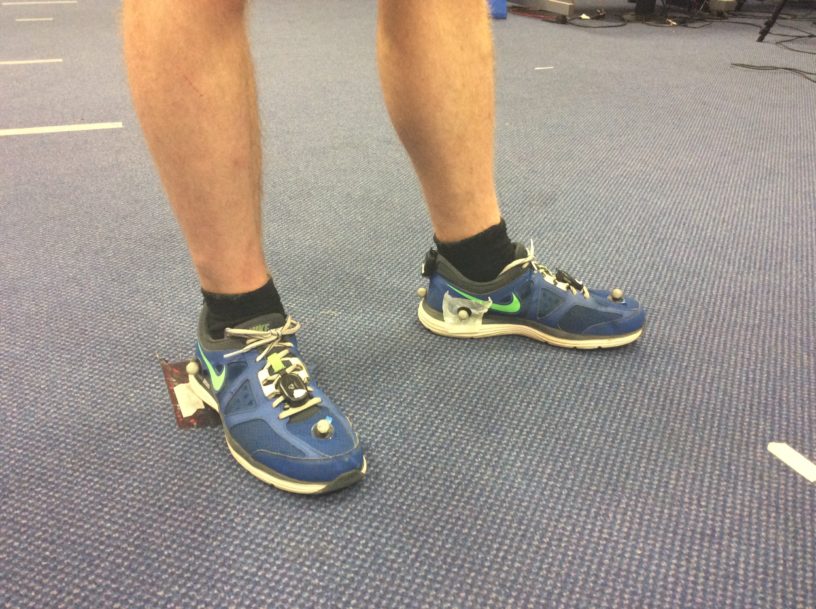Ground contact time during running is defined as the time elapsed between initial ground contact and toe off. The gold standard in measuring ground contact time during running is high speed video, where heel strike and toe off are manually digitised to find the time elapsed. This system is limited for reasons including the time consuming process of manual digitisation, as well as the restriction to recording on a treadmill or limited number of steps in the field. Additionally, in order to achieve millisecond accuracy, expensive research grade cameras are required.
Advancements in technology have enabled running measurements to be collected in a field based setting through the use of relatively inexpensive accelerometers and gyroscopes, also referred to as inertial measurement units (IMUs). IMUs have been found to be accurate for measuring human movement(1,2), including measurement of running specific gait events with IMUs mounted in different locations. Recent studies include a tri-axial accelerometer placed on the distal tibia(3), accelerometers placed on both heel and toe of running shoes(4), and by a gyroscope placed inside the midsole(5). This study was started during the RunScribe development stage to test and refine the footsteps model. The results are reflective of the final footsteps model implemented in the consumer version of RunScribe.
[Tweet “Ground contact time during running is defined as the time elapsed between initial ground contact and toe off.”]Methods:
Sixteen injury free participants completed 2 minute running trials of 8, 12, and 16 km/hr (approximately 12, 8 and 6 minutes per mile pace) on a motorised treadmill(h/p Cosmos, Quasar med, HP-Cosmos Sports and Medical GMbH, Nussdorf-Traunstein, Germany) while data was synchronously collected from four RunScribe footpads, positioned on the heel and laces of both feet, and a high speed video camera (Phantom Miro 110, Vision Research, New Jersey, USA) at 1000 fps. Participants were given time to warm up at their discretion and familiarise themselves with the treadmill. To ensure steady state running, 10 strides from the end of each trial were manually digitised and synchronized with the same step recorded by RunScribe. Agreement between the two systems was assessed using Bland Altman limits of agreement(6) and intraclass correlation measuring for absolute agreement.
Results:


Discussion:
Contact time measured by RunScribe showed good overall agreement to the gold standard method of high speed video. Intraclass correlation coefficient (ICC) between both systems showed good agreement for all speeds measured, and in both mounting locations(All ICC > .8 p<0.01). Accuracy was not statistically dependent on foot or mounting location. Running at the slowest speed, 8 km/hr, showed an increased variability in RunScribe accuracy. This could be due in part to the slow pace causing unnatural running gait, as was observed by the researcher. Measurement differences between systems showed no pattern based on speed or mounting location. Some outliers showed a much larger difference between systems, as seen in the correlation plot. These outliers tended to occur at the slowest speed, when running pattern was more variable. Outliers are expected in any embedded system and are a source of continuing algorithm refinement.
A limitation of this study is human error in manual digitisation of footstrike and toe off, as these events can be difficult to pinpoint in a single frame, and measurement error could vary slightly between participants. Future research should focus on participant selected speeds and look for interaction based on foot strike type and shoe. RunScribe was found to be a reliable and sensitive tool for detecting small differences in contact times during treadmill running and can allow for ecologically valid measurements of running in the field.
References:
- Cuesta-Vargas A. The use of inertial sensors system for human motion analysis. Physical Therapy Reviews. 2010;15(6):462-473. doi: 10.1179/1743288X11Y.0000000006.
- Fong DT, Chan Y. The use of wearable inertial motion sensors in human lower limb biomechanics studies: A systematic review. Sensors (Basel, Switzerland). 2010;10(12):11556-11565. doi: 10.3390/s101211556.
- Purcell B, Channells J, James D, Barrett R. Use of accelerometers for detecting foot- ground contact time during running. . 2005:603615-603615-8.
- Boutaayamou M, Schwartz C, Stamatakis J, et al. Development and validation of an accelerometer-based method for quantifying gait events. Med Eng Phys. 2015;37(2):226-232.
- Sinclair J, Hobbs SJ, Protheroe L, Edmundson CJ, Greenhalgh A. Determination of gait events using an externally mounted shank accelerometer. Journal of applied biomechanics. 2013;29(1):118-122.
- Bland JM, Altman DG. Measuring agreement in method comparison studies. Stat Methods Med Res. 1999;8(2):135-160. doi: 10.1191/096228099673819272.

